-
zł
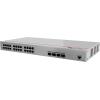
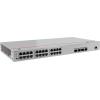

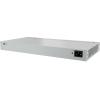
Huawei S310-24P4S is a manageable switch from the eKitEngine series. It features 24 gigabit Ethernet ports (10/100/1000 Mbps) and 4 SFP slots (1 Gbps). All Ethernet ports have PoE+ output, with a maximum power per port of 15.4 W for 802.3af or 30 W for 802.3at. The total power budget for the entire device is 400 W, significantly more than what cheaper S110 series solutions offer. The switch provides Layer 2 management and basic Layer 3 functions. It supports Spanning Tree Protocols (STP / RSTP / MSTP) and the modern ERPS (Ethernet Ring Protection Switching) standard. It features Smart Link, allowing for the creation of backup connections. Devices from the S310 series can be connected to multiple aggregating switches using multiple connections, ensuring network operation in case of cable failure. The product stands out with advanced security features, protecting against various attacks such as DoS, IP/MAC spoofing, and SYN flood. It utilizes DHCP Snooping and ARP entry recording to guard against ARP spoofing. Another advantage is iStack support, enabling multiple switches to be virtually stacked into one device. Management can be done through the Web UI, CLI, or SNMP. The device supports cloud management and the eKit app. It comes with a built-in AC power supply and active cooling with intelligent fan speed adjustment. The S310-24P4S combines the functions of a core and access switch. With PoE+ support, you can directly connect access points, which is suitable for small and medium-sized networks. Moreover, you don't compromise on advanced management capabilities offered by the S310 switch series.
The new firmware version (R24 or later) significantly reduces boot time, improves fan operation management, and greatly enhances control via the Web UI. It allows the configuration of most parameters through the graphical interface, whereas many features were previously accessible only via the CLI.
We recommend updating your devices to version R24! You can obtain the firmware from our support team at support@cdr.pl.24x gigabit Ethernet, 4x SFP
The switch is equipped with 24 gigabit Ethernet ports (10/100/1000 Mbps) and 4 SFP slots (1 Gbps). It has a switching capacity of 56 Gbps and a packet forwarding rate of 42 Mp/s. Using one of the SFP slots, you can establish a connection over very long distances using fiber optic cable.

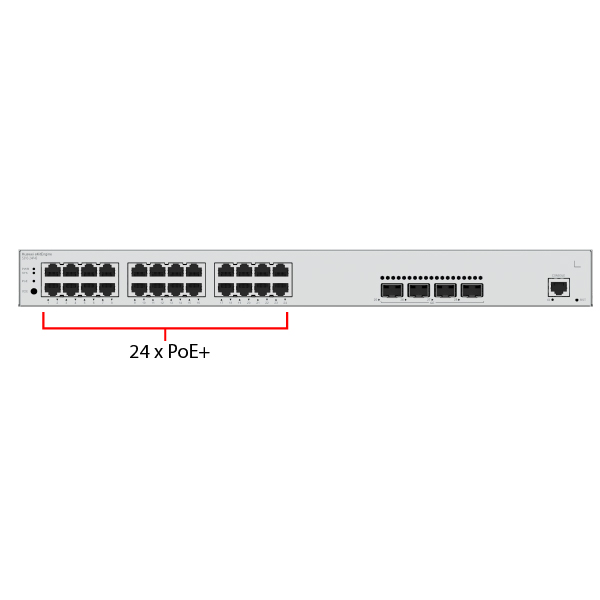
24 PoE+ outputs
On all Ethernet ports, there is PoE+ power output. The maximum output power per port, according to standards, is 15.4 W for 802.3af or 30 W for 802.3at. The total power budget for the entire device is 400 W, significantly more than what solutions from the S110 series offer. This allows you to power all ports using the 802.3af standard, which is necessary in large networks with many access points.
The use of PoE allows you to power and transmit data using Ethernet cable. With such a switch, you only need to run one cable to each access point, eliminating the need for additional power supplies.
Layer 2+ management, iStack
The device fully supports Layer 2 management and also includes basic Layer 3 functions such as static routing. It supports VLANs, multicasts (IGMP Snooping, MLD Snooping), QoS, and Access Control Lists (ACL). It also supports Spanning Tree Protocols (STP / RSTP / MSTP) and the modern ERPS (Ethernet Ring Protection Switching) standard defined in ITU-T G.8032.
The switch provides essential network security features. It protects against DoS attacks such as SYN flood, Land, Smurf, and ICMP flood. It also has protection against user-targeted attacks, including rogue DHCP server attacks, IP/MAC spoofing, DHCP request flood, and DHCP CHADDR attacks.
The S310 series supports the iStack function, allowing multiple switches to be logically stacked into a single virtual switch. This simplifies network management and enables the creation of additional backup connections, providing protection against potential failures.
Management is performed through a graphical Web interface, CLI, or using SNMP (v1, v2c, v3) / SSH2.0. Devices in the S310 series can also be managed in the cloud, and in this case, you can additionally use the Huawei eKit app.
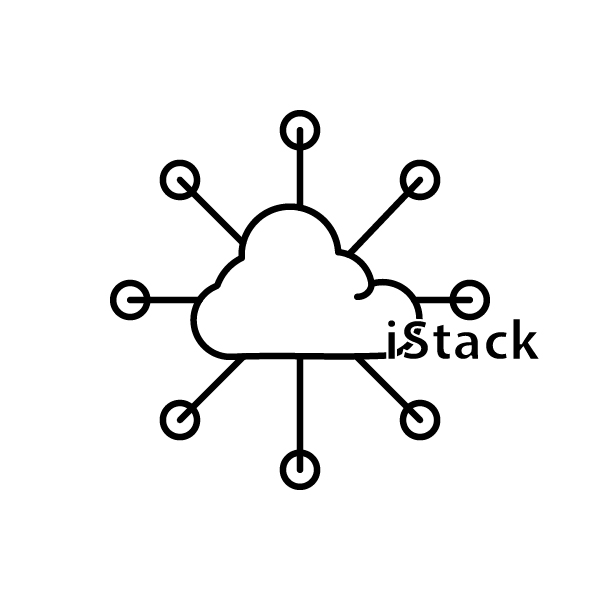
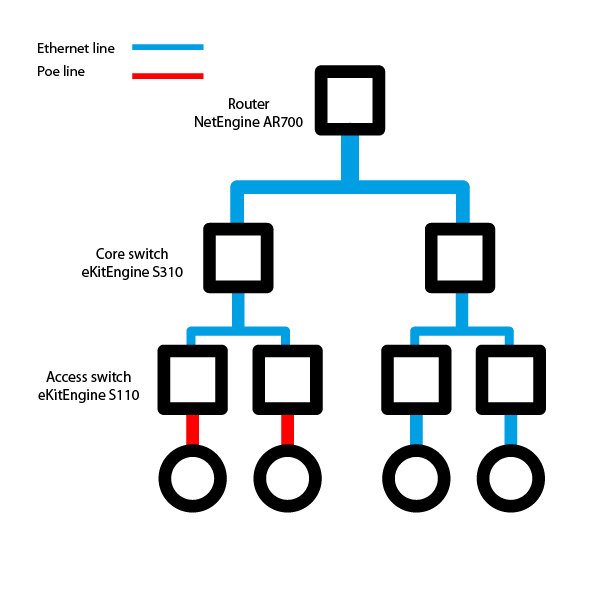
Usage
The S310-24P4S combines the features of both a core and access switch. It boasts advanced management functions and supports iStack. Additionally, it features PoE power output on all Ethernet ports. This device is ideal for office networks with several access points. You won't need to use additional PoE switches, reducing the cost of network deployment.
Specifications
| Huawei S310-24P4S | |
| Switching Capacity | 56 Gb/s |
| Packet forwarding | 42 Mp/s |
| Fixed port |
24x gigabit Ethernet 10/100/1000 Mb/s with PoE+ 4x SFP (1 Gb/s) |
| Chassis dimensions (H x W x D) | 43.6 mm x 442 mm x 220 mm |
| Chassis height | 1U |
| Weight | 2,92 kg |
| Power module type | Built-in AC power module |
| Rated voltage | 100 - 240 V AC, 50/60 Hz |
| Maximum voltage | 90 - 290 V AC, 55/65 Hz |
| Maximum power consumption |
Without PoE: 47,1 W With PoE: 491,66 W (PoE: 400 W) |
| Noise |
Sound power at normal temperature: 49,3 dB (A) Sound power at high temperature: 63 dB (A) |
| Long-term operating temperature | –5°C to +50°C |
| Storage temperature | –40°C to +70°C |
| Relative humidity | 5% to 95% (noncondensing) |
| Service port surge protection | Common mode: ±7 kV |
| Power port surge protection | Differential mode: ±6 kV Common mode: ±6 kV |
| Heat dissipation mode | Air cooling, intelligent fan speed adjustment |
| Service features | |
|---|---|
| MAC address table | Automatic MAC address learning and aging 16K MAC address entries at maximum Static, dynamic, and blackhole MAC address entries Source MAC address filtering Limitation on the number of MAC addresses learned by an interface |
| VLAN features | 4094 VLANs Voice VLAN MUX VLAN VLAN assignment based on MAC addresses, protocols, IP subnets, policies, and ports VLAN stacking |
| Ethernet switching | Smart Link tree topology and Smart Link multi-instance, providing millisecond-level protective switchover G.8032 Ethernet Ring Protection Switching (ERPS) Smart Link tree topology and Smart Link multi-instance, providing millisecond-level protective switchover G.8032 Ethernet Ring Protection Switching (ERPS) |
| Multicast | IGMPv1/v2/v3, IGMPv1/v2/v3 snooping and MLD snooping |
| IP routing | Static routing and policy-based routing (PBR) 512 FIBv4 entries at maximum 512 FIBv6 entries at maximum |
| IPv6 features | Neighbor discovery (ND) PMTU IPv6 ping, IPv6 tracert, and IPv6 telnet |
| Reliability | Link Aggregation Control Protocol (LACP) Virtual Router Redundancy Protocol (VRRP) Bidirectional Forwarding Detection (BFD) Link Layer Discovery Protocol (LLDP) |
| QoS/ACL | Traffic rate limiting in the inbound and outbound directions of a port Packet redirection Port-based traffic policing and two-rate three-color CAR Eight queues on each port DRR, SP and DRR+SP queue scheduling algorithms Re-marking of the 802.1p and DSCP priorities for packets Packet filtering on Layer 2 to Layer 4, filtering out invalid frames based on the source MAC address, destination MAC address, source IP address, destination IP address, TCP/UDP port number, protocol type, or VLAN Rate limiting in each queue and traffic shaping on ports Network Slicing (VLAN/VXLAN) |
| Security features | Hierarchical user management and password protection Defense against DoS, ARP, and ICMP attacks Binding of the IP address, MAC address, port ID, and VLAN ID Port isolation, port security, and sticky MAC Blackhole MAC address entries Limitation on the number of learned MAC addresses IEEE 802.1X authentication and limit on the number of users on a port Multiple authentication modes including AAA, RADIUS, HWTACACS and NAC authentication SSH v2.0 HTTPS CPU defense Blacklist and whitelist DHCP client, DHCP relay, DHCP server, DHCP snooping DHCPv6 client, DHCPv6 relay |
| Management and maintenance |
iStack Cloud management based on NETCONF/YANG Virtual cable test (VCT) Remote configuration and maintenance by using Telnet SNMPv1/v2/v3 RMON Web system-based management HTTPS LLDP/LLDP-MED System logs and alarms based on severities 802.3az: Energy Efficient Ethernet (EEE) IFIT Port mirroring Deployment through the registration query center |
| Interoperability | VBST, working with PVST, PVST+, and RPVST |






 Polski
Polski English
English Italiano
Italiano Español
Español Čeština
Čeština Српски
Српски Deutsch
Deutsch Ελληνικά
Ελληνικά Slovenský
Slovenský




